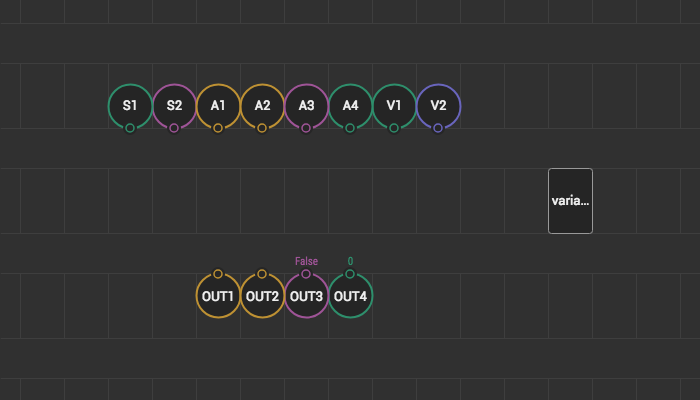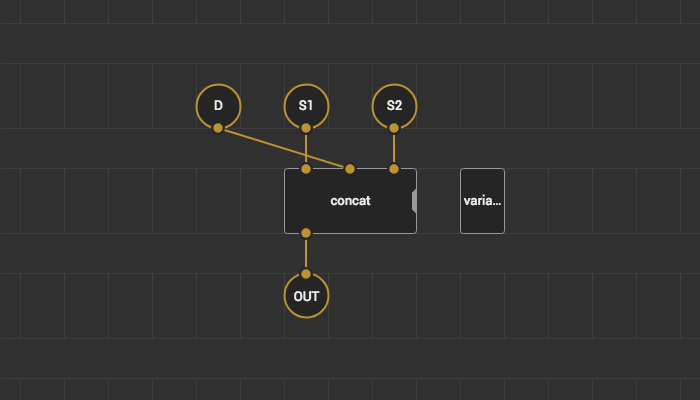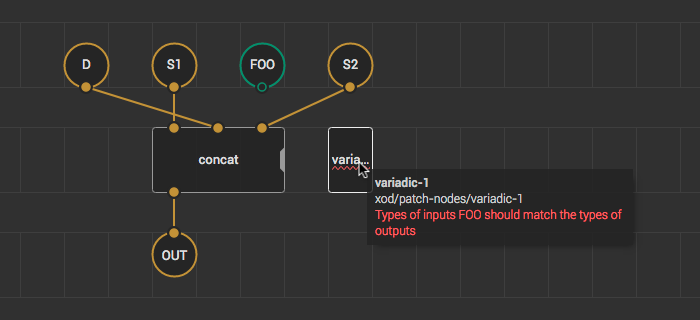Creating Variadic Patch Nodes
Declaring your patch node to be variadic allows its user to add or remove similar input pins dynamically. For you, it is a way to avoid creating a list of mechanical variations to support the various number of inputs like:
foobarfoobar-2foobar-3- …
foobar-8
Make sure you’re familiar with the variadic nodes concept and understand how the expansion process works.
Markers #
To make your patch node variadic, you should place a special marker node on it. Find the marker node under the xod/patch-nodes library. You need variadic-1, variadic-2, or variadic-3. The number defines the arity step, that is the group size by which the rightmost input pins replicate.
The variadic-* node itself does nothing and is stripped out during compilation. It exists solely to define indefinite arity support.
Pin assignments #
Whenever you place a variadic node marker, the input pins get roles depending on their position relative to each other. Consider a patch node draft with a variadic-2 marker:

To make the expansion XOD split pins of a variadic patch node into three groups.
Variadic pins (aka value pins). The rightmost pins get this role. Their number equals to the arity step. In the example above they are V1 and V2. Values for the inputs on each level are provided by a node user.
Accumulator pins. Pins in the middle get this role. Their number equals the output number. In the example they are A1, A2, A3, and A4. The user provides values only for the top level of the cascade; all other levels get accumulator values straightly from output pins of the respective upstream node.
Shared pins. The leftmost pins which are not variadic nor accumulator get this role. In the example they are S1 and S2. The values are provided by the user, and they are delivered to each level in the cascade as is. In many cases there will be no shared pins.
Finally, consider a string join node example. We want a node which takes an arbitrary number (two or more) of input strings and joins them together inserting a delimiter between each. For example, it joins "foo", "bar", "baz" with delimiter "; " into "foo; bar; baz". The delimiter is shared between all levels of expansion, so its input terminal goes left. We want the arity to increment one by one, so we use the variadic-1 marker. Finally, a possible patch node implementation may look like this:

Rules #
To let XOD properly expand your variadic node when transpiling you must satisfy several natural restrictions:
- There should be no more than a single
variadic-*marker. - A variadic patch node should have at least one output.
- The total number of inputs should be equal or greater than the number of outputs plus the arity step.
- The types of accumulator inputs must strictly match the types of the outputs even if an implicit cast is allowed in other cases.
On the patch board, the variadic marker nodes either render usually or in red color. The later case tells you’re breaking some rules.

Hover the node to see the error. You have to resolve all issues or remove the marker node to make the program compile successfully.
Hiding implementation details with variadic-pass nodes #
The rules for pin placement and types are necessary for properly expanding your variadic node, but you may not want to show all the pins to the end user. With variadic-pass nodes, you can sweep all the implementation details under the rug.